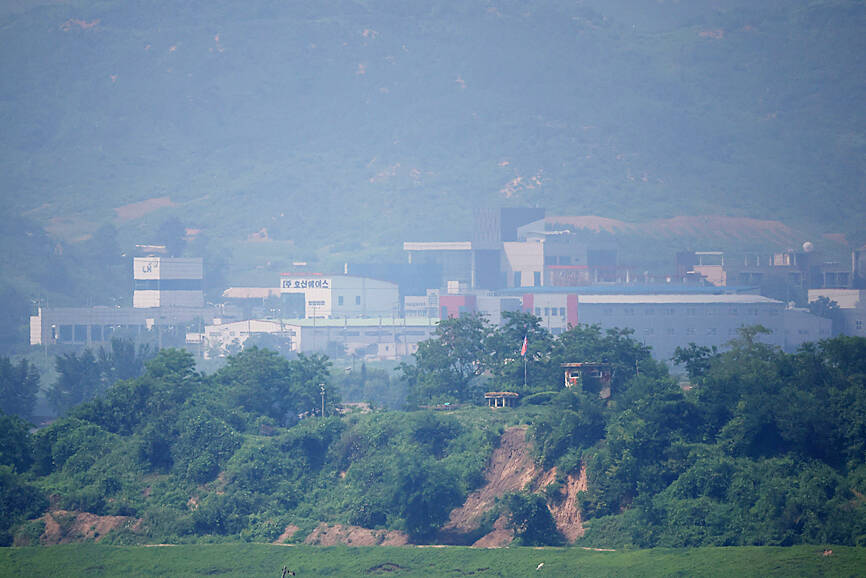South Korea yesterday warned that it would take “necessary steps” if Pyongyang continues its unauthorised use of a joint industrial complex in the North once seen as a symbol of reconciliation.
More than 50,000 North Korean workers once worked at the Kaesong Industrial Complex, churning out products from watches to clothes for about 125 South Korean companies that supplied the funding and equipment.
Seoul pulled out of the venture — launched in the wake of the 2000 inter-Korean summit — in 2016 in response to a nuclear test and missile launches by the North, saying that Kaesong profits were being used to fund the North’s provocations.

Photo: AFP
However, the North has continued using the facility and its South Korean-owned assets without permission, the South Korean Ministry of Unification said.
The South Korean Liaison Office yesterday sent a notice demanding activity at the factory complex to cease, but North Korea refused to accept it, the ministry said.
The announcement came a day after North Korea’s Rodong Sinmun newspaper released a set of photographs showing what appeared to be a South Korean bus that was once used to carry workers to the complex running in Pyongyang.
The continued operation of the facilities “regardless of the will of the businesspeople is a clear violation of property rights” and the two Koreas’ agreement on investment guarantees, the ministry cited the notice as saying.
“North Korea should stop this immediately. If there is no corresponding response from North Korea regarding our request, we will take necessary steps assuming that North Korea has admitted to operating the complex without permission,” the notice said.
What action might be taken was not specified.
While open, the business park was virtually the last remaining form of economic cooperation between the Koreas.
It provided precious hard currency for the impoverished North, and cheap labor and tax breaks for the companies involved in the venture.
North Korea has doubled down on the expansion of its military arsenal and nuclear program since a 2019 Hanoi summit between North Korean leader Kim Jong-un and then-US president Donald Trump failed to yield any meaningful outcome.
In recent weeks, it has tested what North Korean state media claimed was an underwater, nuclear-capable drone and carried out the launch of an intercontinental ballistic missile.
Officials in Seoul and Washington have warned since the beginning of last year that North Korea could be preparing to conduct its seventh nuclear test, with some experts saying it could be imminent.

BOMBARDMENT: Moscow sent more than 440 drones and 32 missiles, Volodymyr Zelenskiy said, in ‘one of the most terrifying strikes’ on the capital in recent months A nighttime Russian missile and drone bombardment of Ukraine killed at least 15 people and injured 116 while they slept in their homes, local officials said yesterday, with the main barrage centering on the capital, Kyiv. Kyiv City Military Administration head Tymur Tkachenko said 14 people were killed and 99 were injured as explosions echoed across the city for hours during the night. The bombardment demolished a nine-story residential building, destroying dozens of apartments. Emergency workers were at the scene to rescue people from under the rubble. Russia flung more than 440 drones and 32 missiles at Ukraine, Ukrainian President Volodymyr Zelenskiy

COMPETITION: The US and Russia make up about 90 percent of the world stockpile and are adding new versions, while China’s nuclear force is steadily rising, SIPRI said Most of the world’s nuclear-armed states continued to modernize their arsenals last year, setting the stage for a new nuclear arms race, the Stockholm International Peace Research Institute (SIPRI) said yesterday. Nuclear powers including the US and Russia — which account for about 90 percent of the world’s stockpile — had spent time last year “upgrading existing weapons and adding newer versions,” researchers said. Since the end of the Cold War, old warheads have generally been dismantled quicker than new ones have been deployed, resulting in a decrease in the overall number of warheads. However, SIPRI said that the trend was likely

‘SHORTSIGHTED’: Using aid as leverage is punitive, would not be regarded well among Pacific Island nations and would further open the door for China, an academic said New Zealand has suspended millions of dollars in budget funding to the Cook Islands, it said yesterday, as the relationship between the two constitutionally linked countries continues to deteriorate amid the island group’s deepening ties with China. A spokesperson for New Zealand Minister of Foreign Affairs Winston Peters said in a statement that New Zealand early this month decided to suspend payment of NZ$18.2 million (US$11 million) in core sector support funding for this year and next year as it “relies on a high trust bilateral relationship.” New Zealand and Australia have become increasingly cautious about China’s growing presence in the Pacific

Indonesia’s Mount Lewotobi Laki-Laki yesterday erupted again with giant ash and smoke plumes after forcing evacuations of villages and flight cancelations, including to and from the resort island of Bali. Several eruptions sent ash up to 5km into the sky on Tuesday evening to yesterday afternoon. An eruption on Tuesday afternoon sent thick, gray clouds 10km into the sky that expanded into a mushroom-shaped ash cloud visible as much as 150km kilometers away. The eruption alert was raised on Tuesday to the highest level and the danger zone where people are recommended to leave was expanded to 8km from the crater. Officers also